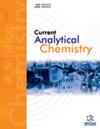Deep Learning-enhanced Hyperspectral Imaging for the Rapid Identification and Classification of Foodborne Pathogens
IF 1.7
4区 化学
Q3 CHEMISTRY, ANALYTICAL
引用次数: 0
Abstract
Background: Bacterial cellulose (BC) is a versatile biomaterial with numerous applications, and the identification of bacterial strains that produce it is of great importance. This study explores the effectiveness of a Stacked Autoencoder (SAE)-based deep learning method for the classification of bacterial cellulose-producing bacteria. Objective: The primary objective of this research is to assess the potential of SAE-based classification models in accurately identifying and classifying bacterial cellulose-producing bacteria, with a particular focus on strain GZ-01. objective: The primary objective of this research is to assess the potential of SAE-based classification models in accurately identifying and classifying bacterial cellulose-producing bacteria, with a particular focus on strain GZ-01. Methods: Strain GZ-01 was isolated and subjected to a comprehensive characterization process, including morphological observations, physiological and biochemical analysis, and 16S rDNA sequencing. These methods were employed to determine the identity of strain GZ-01, ultimately recognized as Acetobacter Okinawa. The study compares the performance of SAE-based classification models to traditional methods like Principal Component Analysis (PCA). Results: The SAE-based classifier exhibits outstanding performance, achieving an impressive accuracy of 94.9% in the recognition and classification of bacterial cellulose-producing bacteria. This approach surpasses the efficacy of conventional PCA in handling the complexities of this classification task. Conclusion: The findings from this research highlight the immense potential of utilizing nanotechnology- driven data analysis methods, such as Stacked Autoencoders, in the realm of bacterial cellulose research. These advanced techniques offer a promising avenue for enhancing the efficiency and accuracy of bacterial cellulose-producing bacteria classification, which has significant implications for various applications in biotechnology and materials science.深度学习增强型高光谱成像技术用于食源性病原体的快速识别和分类
背景:细菌纤维素(BC)是一种用途广泛的生物材料,其应用领域非常广泛,而鉴定产生这种材料的细菌菌株则非常重要。本研究探讨了基于堆栈式自动编码器(SAE)的深度学习方法在细菌纤维素生产菌分类中的有效性。研究目的本研究的主要目的是评估基于 SAE 的分类模型在准确识别和分类细菌纤维素产生菌方面的潜力,尤其关注菌株 GZ-01。目标:本研究的主要目的是评估基于 SAE 的分类模型在准确识别和分类细菌纤维素产生菌方面的潜力,尤其关注菌株 GZ-01:本研究的主要目的是评估基于 SAE 的分类模型在准确识别和分类细菌纤维素生产菌方面的潜力,尤其侧重于菌株 GZ-01。研究方法:分离菌株 GZ-01 并对其进行全面鉴定,包括形态观察、生理生化分析和 16S rDNA 测序。通过这些方法确定了 GZ-01 菌株的身份,最终确认其为冲绳醋酸杆菌。该研究比较了基于 SAE 的分类模型与传统方法(如主成分分析 (PCA))的性能。结果显示基于 SAE 的分类器表现出色,在识别和分类产纤维素细菌方面的准确率高达 94.9%,令人印象深刻。在处理这项复杂的分类任务时,这种方法超越了传统 PCA 的功效。结论这项研究的结果凸显了利用纳米技术驱动的数据分析方法(如堆叠自动编码器)在细菌纤维素研究领域的巨大潜力。这些先进的技术为提高细菌纤维素产生菌分类的效率和准确性提供了一条大有可为的途径,对生物技术和材料科学领域的各种应用具有重要意义。
本文章由计算机程序翻译,如有差异,请以英文原文为准。
求助全文
约1分钟内获得全文
求助全文
来源期刊

Current Analytical Chemistry
化学-分析化学
CiteScore
4.10
自引率
0.00%
发文量
90
审稿时长
9 months
期刊介绍:
Current Analytical Chemistry publishes full-length/mini reviews and original research articles on the most recent advances in analytical chemistry. All aspects of the field are represented, including analytical methodology, techniques, and instrumentation in both fundamental and applied research topics of interest to the broad readership of the journal. Current Analytical Chemistry strives to serve as an authoritative source of information in analytical chemistry and in related applications such as biochemical analysis, pharmaceutical research, quantitative biological imaging, novel sensors, and nanotechnology.
 求助内容:
求助内容: 应助结果提醒方式:
应助结果提醒方式:


